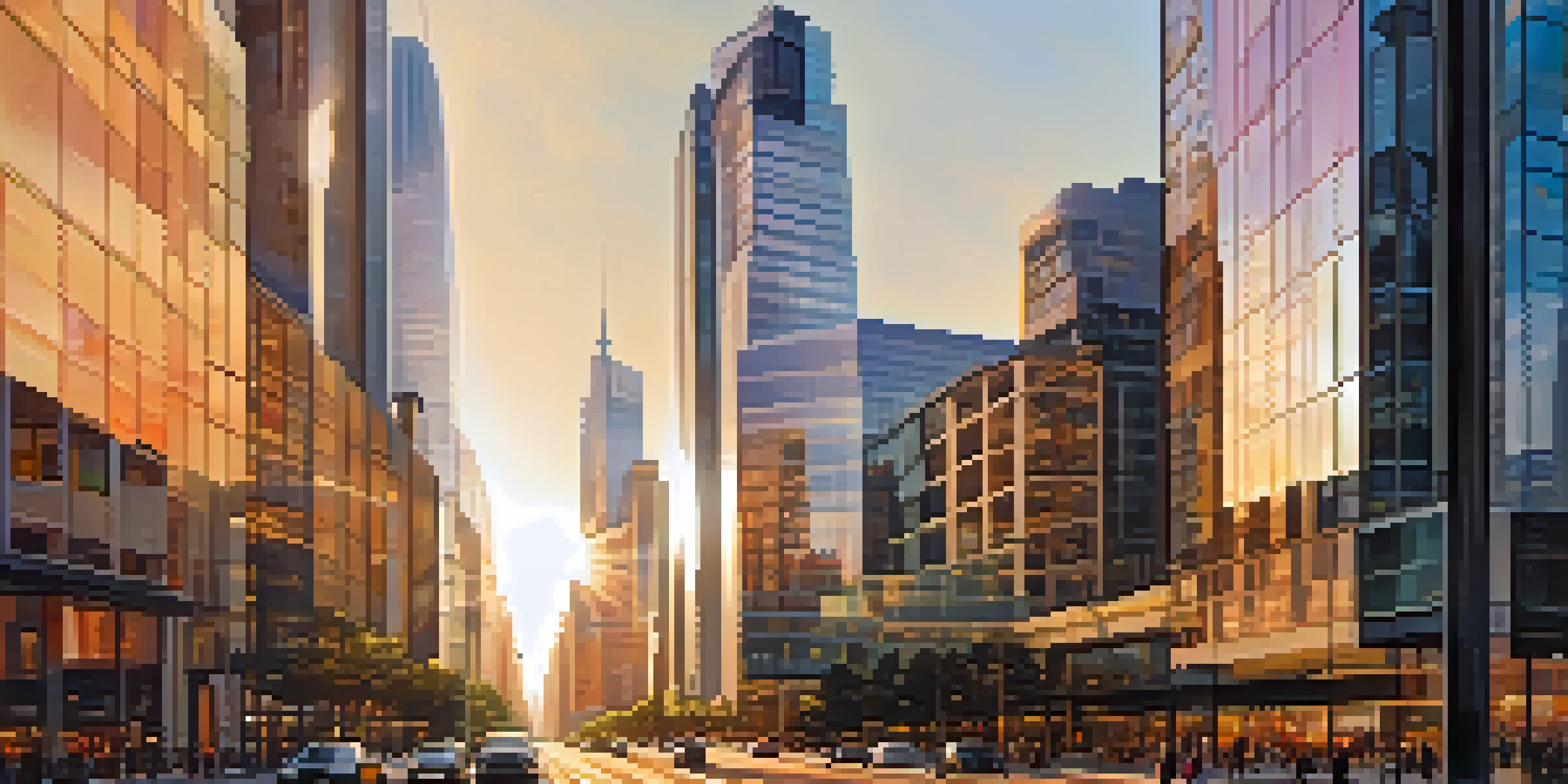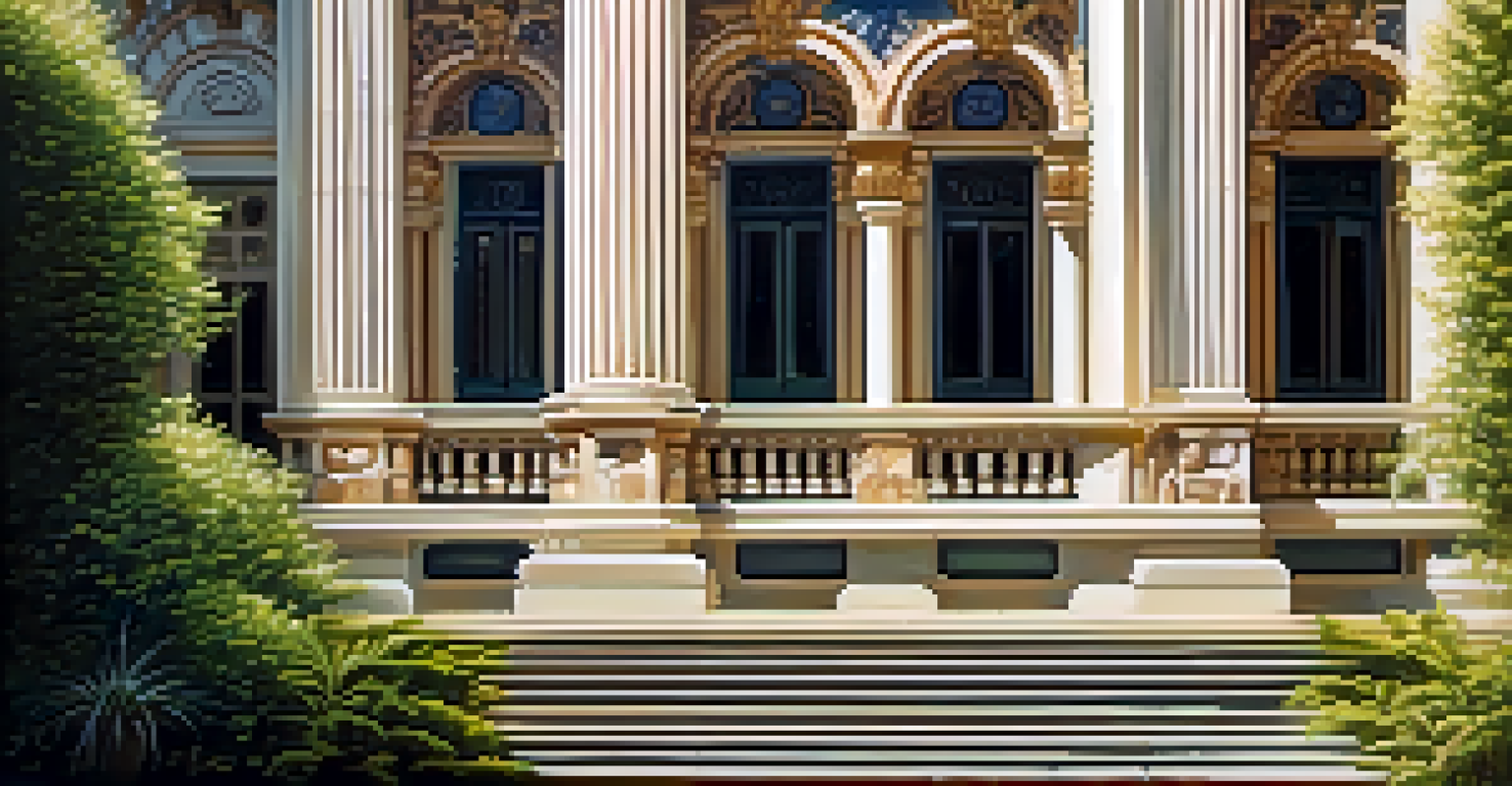The Aesthetic Value of Architectural Photography in Art

Understanding Architectural Photography as an Art Form
Architectural photography is more than just capturing buildings; it's an art form that unites design and visual storytelling. Through thoughtful composition and lighting, photographers can highlight the unique features of structures while also conveying a sense of space and emotion. This genre serves as a bridge between architecture and fine art, transforming everyday structures into captivating visual narratives.
Architecture is the learned game, correct and magnificent, of forms assembled in the light.
Consider how a photograph of a skyscraper can evoke feelings of awe or tranquility, depending on the angle and lighting. The photographer's choices impact not just what we see but how we feel about the building itself. By emphasizing lines, shapes, and textures, architectural photography reveals the artistry behind the architecture, encouraging viewers to appreciate the design more deeply.
In essence, architectural photography invites us to see buildings not just as functional spaces but as artistic expressions. It challenges us to look beyond the physical structure and engage with the story it tells. This marriage of art and architecture enriches our understanding of both disciplines.
The Role of Composition in Architectural Photography
Composition is a crucial element in architectural photography, shaping how we perceive a structure. By utilizing techniques like the rule of thirds or leading lines, photographers can guide the viewer's eye and create a sense of balance. These compositional choices not only enhance the visual appeal but also communicate the architect's intent and the building's purpose.

For example, a wide-angle shot can emphasize the grandeur of a building, making it seem larger than life. Conversely, an intimate close-up can reveal intricate details that might be overlooked. Each composition tells a different story, allowing the viewer to connect with the architecture on various levels.
Architectural Photography as Art
Architectural photography merges design and storytelling, transforming buildings into captivating visual narratives.
Ultimately, composition in architectural photography is about more than aesthetics; it's about creating a dialogue between the viewer and the structure. It encourages us to appreciate the thought and creativity that go into architectural design, fostering a deeper appreciation for both the art of photography and the art of building.
Lighting: The Life Force of Architectural Photography
Lighting is arguably the most vital aspect of architectural photography, as it can dramatically transform the perception of a building. Natural light, in particular, plays a crucial role in highlighting textures, colors, and shapes. The golden hour, just after sunrise or before sunset, is often considered the ideal time for capturing architecture, as it bathes structures in a warm, flattering glow.
Photography is the story I fail to put into words.
Consider how a stark, midday sun can cast harsh shadows and create unflattering contrasts, whereas soft, diffused light can reveal the subtleties of a building's design. Photographers often experiment with different lighting conditions to evoke specific moods and atmospheres, enhancing the viewer's emotional response to the image.
In this sense, mastering lighting is essential for any architectural photographer. It allows them to manipulate how a structure is perceived, making it a key component in conveying the aesthetic value of architecture through photography.
The Impact of Perspective in Architectural Photography
Perspective is another powerful tool in architectural photography, influencing how a viewer interprets a building. By changing their vantage point—whether shooting from above, below, or at an angle—photographers can create a sense of scale or intimacy. This shift in perspective can evoke different emotions and highlight various aspects of the architecture.
For instance, a low-angle shot can make a building appear monumental, while a bird's-eye view can provide context within its surroundings. Each perspective not only alters the visual narrative but also alters our perception of the building's significance and its relationship to the environment.
Lighting Shapes Perception
The quality of light in architectural photography can dramatically alter how structures are perceived and the emotions they evoke.
Ultimately, perspective invites viewers to engage with architecture in new and exciting ways. It challenges preconceptions and encourages a deeper exploration of the built environment, showcasing how architectural photography can transform our understanding of space.
The Intersection of Architecture and Culture in Photography
Architectural photography often serves as a reflection of cultural values and historical context, offering insights into the society that created it. Each building tells a story, embodying the aspirations, challenges, and innovations of its time. By capturing these structures, photographers document not just architectural styles but also the cultural narratives that surround them.
For example, modern skyscrapers may signify economic progress, while historical buildings might evoke nostalgia or a sense of heritage. Photographers have the unique opportunity to highlight these cultural connections, allowing viewers to appreciate the broader implications of architectural design.
In this way, architectural photography becomes a lens through which we can examine societal evolution. It prompts us to consider how architecture shapes and is shaped by cultural dynamics, enriching our understanding of both art and society.
The Emotional Resonance of Architectural Photography
One of the most fascinating aspects of architectural photography is its ability to evoke emotions. A photograph can transport the viewer, allowing them to experience the space as if they were standing in it. Whether it's the serenity of a minimalist design or the chaos of a bustling urban scene, the emotional impact of architecture can be powerfully conveyed through photography.
For instance, consider the dramatic lines of a Gothic cathedral, which might inspire feelings of awe and wonder. In contrast, a cozy cottage may evoke warmth and nostalgia. These emotional responses remind us that buildings are not just physical structures; they are spaces filled with memories, stories, and experiences.
Perspective Influences Emotion
Changing the vantage point in architectural photography can evoke different feelings and highlight various aspects of a building's design.
Thus, architectural photography has the power to connect us on a personal level. It invites us to explore our own emotions while appreciating the beauty and intricacies of the built environment, fostering a deeper relationship with architecture.
The Future of Architectural Photography in the Digital Age
As technology continues to evolve, so too does architectural photography. The rise of digital platforms and social media has transformed how we share and experience architectural images. Photographers now have the ability to reach a global audience, showcasing their work to a diverse range of viewers and inspiring new conversations about architectural aesthetics.
Additionally, advancements in camera technology and editing software allow for greater creativity and precision in capturing architectural beauty. Photographers can experiment with techniques like HDR imaging or even virtual reality, opening up new possibilities for how architecture is represented and experienced.

Looking ahead, the future of architectural photography is bright and full of potential. With each new technological innovation, photographers have the opportunity to redefine how we perceive and interact with architecture, ensuring that this art form continues to evolve and inspire.